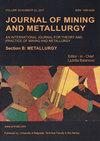Improving the sinter productivity with increased specular iron ore in sinter blend
IF 1
4区 材料科学
Q3 METALLURGY & METALLURGICAL ENGINEERING
Journal of Mining and Metallurgy Section B-Metallurgy
Pub Date : 2022-01-01
DOI:10.2298/jmmb210922009k
引用次数: 1
Abstract
Specular iron ores are medium grade iron ores suitable to use in agglomeration process. However, due to their hard texture, undesirable particle size and shape, poor assimilation performance and low reactivity at high temperature, its uses in agglomeration is very limited and restricted to almost 3-10% at most of the plant. In the present study effect of specular iron ore on sintering performance and sinter qualities are examined. It was observed that an increased proportion of specular iron ore in sinter blend has shown poor sintering performance in both laboratory scale studies and plant scale trials. In the present work, effect of blending of specular iron ore with goethite iron ore in sinter mix on sintering performance is examined and an optimum iron ore blend ratio for sustainable performance and quality is proposed. To increase the specular iron ore usage in sintering, goethitic iron ore up to 30% is introduced in sinter blend to overcome the deteriorating nature of specular iron ore. The goethite iron ore contains chemically bonded water which gets removed at higher temperatures (300-500?C) during sintering. The evaporated water gets cooled at lower bed and condenses which retards the air flow during sintering process and thus the combustion zone stays for longer time allowing better melt assimilation and sinter qualities. The poor melt assimilation of specularite is thus countered in presence of goethite iron ore. Having better reactive and hydrophilic nature of goethite iron ore, nullifying or reducing the ill effect of poor reactive and hydrophobic characteristics of specular iron ore during granulation and sintering process. Due to the which, the blended specular and goethite iron ore resulted in improved sintering rate and consequently improved sinter productivity. The present work proposed usage of up to 30% of specular iron ore when blended with goethite iron ore in sinter making.在烧结矿混合料中增加镜面铁矿,提高烧结矿生产效率
镜面铁矿是一种中等品位的铁矿,适合用于结块工艺。然而,由于其坚硬的质地、不理想的粒度和形状、较差的同化性能和在高温下的低反应性,其在团聚中的应用非常有限,在大多数工厂中限制在几乎3-10%。本文考察了镜面铁矿对烧结性能和烧结质量的影响。在实验室规模的研究和工厂规模的试验中,观察到烧结矿混合物中镜面铁矿石比例的增加表明烧结性能较差。本文研究了在烧结料中掺加镜面铁矿和针铁矿对烧结性能的影响,并提出了可持续性能和质量的最佳掺铁比。为了增加镜面铁矿在烧结中的使用,在烧结矿中加入30%的针铁矿,以克服镜面铁矿变质的性质。针铁矿中含有化学结合的水,在烧结过程中温度升高(300-500℃)就会被去除。蒸发的水在较低的床层被冷却并凝结,这阻碍了烧结过程中的空气流动,因此燃烧区停留的时间更长,从而使熔体同化和烧结质量更好。由于针铁矿具有较好的反应性和亲水性,抵消或减轻了镜面铁矿在造粒和烧结过程中反应性差和疏水性差的不良影响。因此,将镜面铁矿与针铁矿混合后,烧结速率提高,烧结生产率提高。目前的工作建议在烧结生产中使用高达30%的镜面铁矿石与针铁矿混合。
本文章由计算机程序翻译,如有差异,请以英文原文为准。
求助全文
约1分钟内获得全文
求助全文
来源期刊
CiteScore
2.00
自引率
40.00%
发文量
19
审稿时长
2 months
期刊介绍:
University of Belgrade, Technical Faculty in Bor, has been publishing the journal called Journal of Mining and Metallurgy since 1965 and in 1997 it was divided in two independent journals dealing with mining and metallurgy separately. Since 2009 Journal of Mining and Metallurgy, Section B: Metallurgy has been accepted in Science Citation Index Expanded.
Journal of Mining and Metallurgy, Section B: Metallurgy presents an international medium for the publication of contributions on original research which reflect the new progresses in theory and practice of metallurgy. The Journal covers the latest research in all aspects of metallurgy including hydrometallurgy, pyrometallurgy, electrometallurgy, transport phenomena, process control, solidification, mechanical working, solid state reactions, materials processing, surface treatment and relationships among processing, structure, and properties of materials.

 求助内容:
求助内容: 应助结果提醒方式:
应助结果提醒方式:


